The magnolia tree is renowned for its timeless beauty and elegance. Its blooming is a spectacular spectacle that marks the arrival of spring or early summer.
Magnolia trees are known for their large and fragrant flowers that can be found in shades ranging from pure white to pink and purple, but when exactly do these trees bloom? Let’s find out.
Magnolia trees typically bloom between late winter and late spring, but the exact bloom time varies depending on the species of magnolia. Generally, deciduous magnolias bloom in early spring, and evergreen magnolias bloom later in the spring season or in the early summer months.
To learn everything you need about the blooming patterns and requirements of different magnolia varieties, continue reading.
We’ll cover everything from species-specific bloom times to factors influencing the magnolia’s bloom cycle and growing tips.
Key Takeaways
- Magnolia trees bloom between late winter and late spring with exact timings varying based on the species of magnolia.
- Deciduous magnolias, such as the Star magnolia, typically bloom earlier than evergreen varieties.
- The bloom time and health of magnolia trees can be influenced by factors like age, geographic location, and growing conditions.
- Proper care, including correct pruning and protection from late frosts, can ensure consistent and vibrant blooms.
If you’re like most people interested in magnolia trees, you have tons of questions. There’s no need to wonder anymore! I answer the most common and pressing questions in my guide, Magnolia Tree Questions. It’s a must-read!
Magnolia Tree Bloom Times
Magnolias don’t follow a one-size-fits-all blooming schedule. Their diverse varieties, coupled with environmental factors, offer a broad spectrum of bloom times.
Evergreen Magnolia Bloom Times
Evergreen magnolias, such as the Southern magnolia (Magnolia grandiflora) and Sweetbay (Magnolia virginiana), provide the best of both worlds: they retain their lustrous leaves throughout the year and dazzle with blossoms in the right season.
These trees are particularly valued in landscapes for their resilience and the year-round green they bring.
The Southern magnolia, known for its large, beautiful white flowers, typically heralds the onset of warmer days with its bloom time in late spring to early summer.
Deciduous Magnolia Bloom Times
Deciduous magnolias, such as the Star magnolia and Saucer magnolia, are characterized by their seasonal shedding of leaves.
As winter recedes, they come to life with an array of blossoms even before their leaves fully emerge.
The Star magnolia, with its white flowers, usually welcomes spring by bursting into bloom from late March through the end of April.
The Saucer magnolia is a sight to behold with its large, showy flowers in shades of white, pink, and purple around the same time.
Factors That Influence Bloom Times
The beauty of nature is its variability, and magnolias are no exception. Several factors can adjust the internal clocks of these trees:
Geographic Location and Hardiness Zone
Depending on whether a magnolia tree’s home is in a cold climate or a warmer region, the bloom schedule may vary.
Different species of magnolia trees are better suited to different Hardiness Zones, influencing when they flower.
Age and Maturity
A magnolia tree’s bloom might be a long-awaited event, especially for younger trees that need a few more years to mature.
It’s important to be patient with young magnolias; they’ll reward the wait with blossoms in due time.
Growing Conditions
From ensuring the ideal soil pH, which leans toward the acidic, to providing adequate sunlight, the conditions in which a magnolia grows can advance or delay its bloom time.
Species and Varietal Differences
Magnolias are a diverse group. Some species bloom early while late-blooming magnolia species might keep you waiting a bit longer. Each species and variety has its unique rhythm.
What Age Do Magnolia Trees Start Blooming?
Magnolias are not necessarily swift bloomers when young. The time it takes for a magnolia tree to produce its first flowers is intrinsically tied to its age.
While some trees might surprise you with flowers as early as three years after planting, others, especially if grown from seed, may require a decade or more to bloom.
Factors such as the species of magnolia, growing conditions, and care provided, play significant roles.
For instance, the Southern magnolia might bloom when it’s 10 to 15 years old if grown from seed, but a grafted magnolia variety could reward you much earlier.
It’s essential to provide consistent care, ensuring ideal growing conditions to promote earlier blooming.
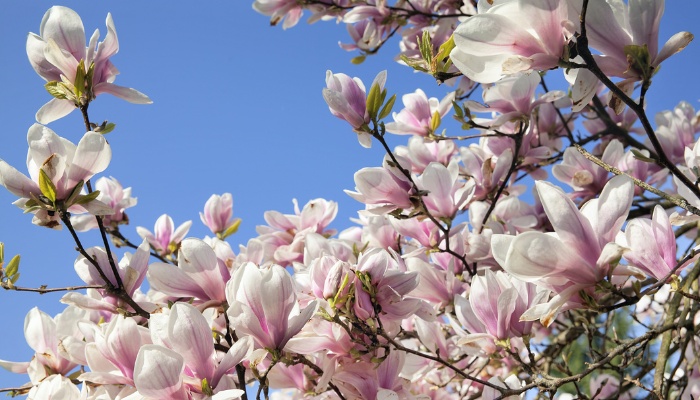
How Long Do Magnolia Trees Flower?
A magnolia’s bloom period is nothing short of magical, but like all good things, it’s fleeting.
Typically, individual magnolia flowers last for about a week or so, depending on the species and environmental conditions.
However, the overall blooming season of a magnolia tree stretches longer, usually spanning several weeks.
While a Star magnolia might dazzle with its blooms for 2-3 weeks in early spring, the Southern magnolia will offer its fragrant flowers from late spring to early summer, blooming sporadically over this period.
It’s the combination of individual blossoms opening at slightly different times that extends the tree’s display, allowing admirers to enjoy its beauty for longer.
Deciduous Magnolia Blooming Periods
Deciduous magnolias are a spectacular sight in any garden or yard. Unlike their evergreen counterparts, these magnolias shed their leaves annually, typically in the fall.
However, their loss is our gain, as it paves the way for a spectacular floral display come spring.
Each deciduous variety has its unique blooming period with some gracing gardens early in the season and others making their debut later.
Let’s explore the distinctive bloom times of some popular deciduous magnolia varieties.
Early Bloomers
When winter’s chill begins to wane and most trees are still bare, early-blooming magnolias take center stage, providing a prelude to spring.
These magnolias are the harbingers of warmer days, emerging into the daylight when many plants remain dormant.
Star Magnolia (Magnolia stellata)

The Star magnolia is a true early riser in the world of flowering trees.
Named for its unique star-shaped white flowers, this magnolia blooms from late March through the end of April, depending on its location and local climate conditions.
Compact and showy, the Star magnolia offers a dazzling display with each flower boasting numerous slender petals that give the tree its signature “starburst” appearance.
Saucer Magnolia (Magnolia × soulangeana)
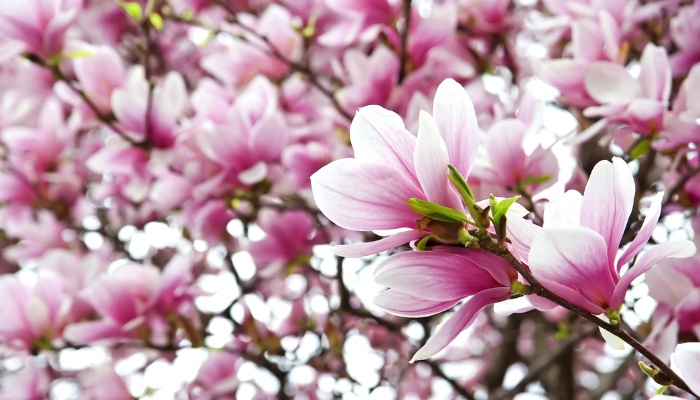
Among the most beloved and recognized magnolias, the Saucer magnolia is known for its large, cup-shaped pink and purple blossoms.
These trees bloom slightly after the Star magnolia, typically unfurling their spectacular petals in early to mid-spring.
Saucer magnolias are a hybrid species, resulting from a cross between Magnolia liliflora and Magnolia denudata.
Their blooms are not just striking in appearance but also fragrant, making them a favorite in many gardens.
Mid-Spring Bloomers
As spring progresses and days grow warmer, mid-spring bloomers take the baton, ensuring the magnolia show continues.
These magnolias bloom once early varieties have concluded their display, bringing renewed beauty to gardens and landscapes.
Jane Magnolia (Magnolia ‘Jane’)

Part of the “Little Girl” series of magnolias, the Jane magnolia offers tulip-shaped flowers that range in color from reddish-purple outside to pale pink inside.
Typically, Jane magnolia trees bloom in mid-spring, offering a more extended display as each blossom can last for several weeks.
They are particularly known for their ability to bloom twice, with a primary bloom in spring and a smaller bloom in summer.
Ann Magnolia (Magnolia liliflora x ‘Ann’)

The Ann magnolia, also from the “Little Girl” series, is cherished for its profusion of deep pink to reddish-purple flowers.
Blooming slightly after the Jane magnolia in mid-spring, it is a resilient variety that often resists late frost damage, ensuring its blooms remain pristine.
Their flower buds are notably hardy, and the flowers themselves are a feast for the eyes, making this magnolia a must-have for those aiming for extended seasonal color.
Late Spring Bloomers
As the curtain begins to close on spring, late-blooming magnolias make their appearance.
Their blooms are a final, memorable act in the springtime magnolia performance, ensuring gardens remain vibrant as summer approaches.
Sweetbay Magnolia (Magnolia virginiana)

Sweetbay magnolias are versatile, able to thrive both as deciduous and semi-evergreen trees, depending on the climate. In colder regions, they tend to be deciduous.
Their creamy-white, lemon-scented flowers make a statement in late spring. Standing tall, these trees can reach up to 60 feet and are frequently found in wet, swampy areas, showcasing their adaptability.
Cucumber Tree Magnolia (Magnolia acuminata)

The name might raise eyebrows, but the cucumber tree magnolia is named for its green, cucumber-like fruit. This magnolia’s blooms are subtly elegant, showcasing pale yellow-green flowers in late spring.
Often overlooked in favor of more showy varieties, the Cucumber Tree magnolia holds its own with a graceful presence and serves as an excellent shade tree.
Evergreen Magnolia Blooming Periods
Evergreen magnolias are true gems in the gardening world. Unlike deciduous magnolias, they retain their glossy, green leaves throughout the year, providing both shade and visual interest even in the colder months.
However, it’s their stunning and fragrant flowers that truly captivate garden enthusiasts.
These blossoms burst forth predominantly in the warmer months, against the backdrop of their thick green foliage, creating a breathtaking contrast.
Here, we’ll explore the blooming periods of some popular evergreen magnolia varieties.
Southern Magnolia (Magnolia grandiflora)
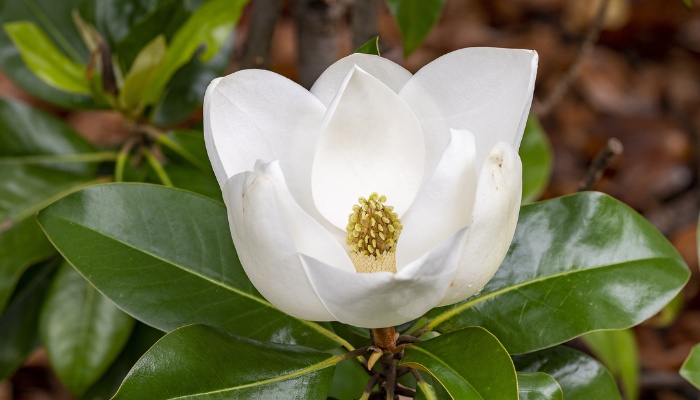
The Southern magnolia, also known as Magnolia grandiflora, is arguably the most iconic of the evergreen magnolias.
Native to the southeastern United States, this magnolia is known for its massive, beautiful white flowers that can span up to a foot in diameter.
Blooming predominantly from late spring to early summer, each flower emits a sweet, heady fragrance that can fill a garden.
It’s not just the flowers that are impressive; the tree itself can grow to monumental heights, often reaching upwards of 80 feet.
This large tree is a symbol of the southern states, with its combination of grandeur, fragrance, and timeless beauty.
Sweetbay Magnolia (Magnolia virginiana)
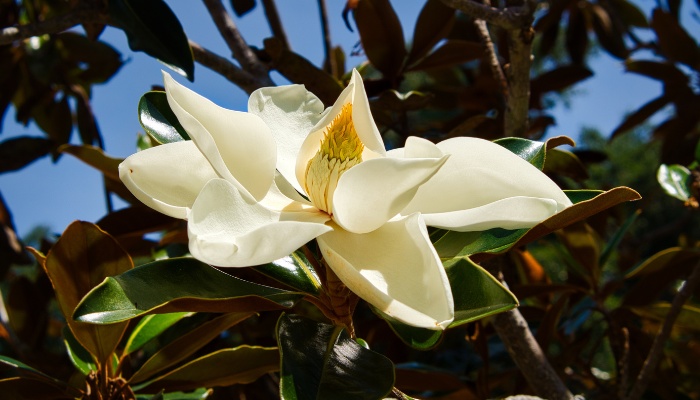
The Sweetbay magnolia, which we touched upon in the deciduous section, displays versatility by growing as an evergreen in milder climates.
In these warmer regions, the Sweetbay retains its leaves throughout the year, providing continuous greenery.
Its delicate, creamy-white flowers, which are often accompanied by a gentle lemony scent, usually appear in late spring to early summer.
This magnolia variety is a favorite among many due to its adaptability and the multi-sensory experience it offers, combining visual allure with olfactory delight.
Little Gem Magnolia (Magnolia grandiflora ‘Little Gem’)
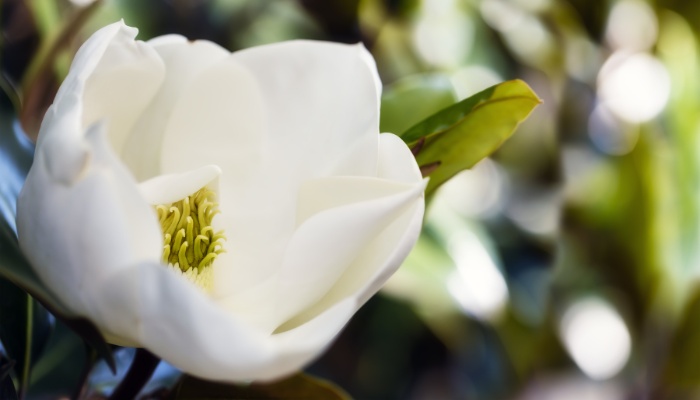
A more compact relative of the grand Southern magnolia, the ‘Little Gem‘ offers the same stunning, fragrant white flowers but on a much smaller scale.
Ideal for gardens with limited space or for those seeking a more manageable tree, the ‘Little Gem’ typically reaches a height of 20-25 feet.
Its blooms make their appearance earlier than the southern magnolia, often gracing gardens from late spring and continuing sporadically throughout the summer.
Its leaves, while smaller than those of the Southern magnolia, are equally glossy and provide a perfect backdrop for the blossoms.
Tips To Keep Magnolias Blooming
Magnolias are undoubtedly some of the most enchanting flowering trees, and with the right care, they can produce an abundance of blooms that add beauty and fragrance to any garden.
Yet, ensuring consistent and vibrant magnolia blooms requires a bit of dedication and understanding.
Let’s explore some tried and true tips that will keep your magnolia displaying its stunning blossoms year after year.
- Soil pH: Magnolias thrive in slightly acidic soil. Test your soil’s pH level, and if it isn’t between 5.5 and 6.5, consider amending it. You can add organic matter, such as pine bark or peat moss, to increase acidity.
- Watering: While magnolias need regular watering, it’s essential to ensure they’re not waterlogged. Overwatering can lead to root rot, which can affect the tree’s overall health and its ability to bloom.
- Sunlight: These trees crave sunlight. Planting your magnolia in an area where it can receive at least six hours of sunlight daily will encourage more blooms. Adequate sunlight is vital for the flower buds to mature and blossom.
- Pruning: Pruning your magnolia can significantly influence its blooming cycle. Prune just after flowering ends, ensuring you don’t accidentally snip off next year’s buds. Prune sparingly, removing only dead or diseased branches.
- Fertilizing: While magnolias aren’t particularly heavy feeders, an annual application of a slow-release, balanced fertilizer can give them the nutrients they need for robust growth and plentiful blooms.
Why Is My Magnolia Not Blooming?
Magnolia trees are known for their vibrant and fragrant blooms. Yet, there may come a time when you notice your magnolia tree isn’t producing as many flowers, or perhaps it doesn’t flower at all.
Understanding the potential reasons can help address the issue and restore your tree to its full blooming glory.
- Age of the Tree: Young magnolia trees might not bloom for the first few years. A young magnolia may put its energy into growing taller and stronger rather than producing flowers. Patience is key here.
- Improper Pruning: If you prune your magnolia at the wrong time of year, you may inadvertently remove the flower buds set for the next season. Always ensure you’re pruning at the right time and only when necessary.
- Environmental Stress: Late frosts can damage emerging buds, preventing them from blossoming. Similarly, prolonged periods of drought can stress the tree, affecting its ability to produce blooms.
- Poor Soil Conditions: Magnolias thrive in well-draining, slightly acidic soil. If the soil is too alkaline or doesn’t drain well, it might inhibit blooming.
- Lack of Sunlight: Magnolias need a lot of sunlight to bloom effectively. If your tree is planted in a shady area or overshadowed by taller trees or buildings, it might not receive the sunlight it needs to flower.
- Pests and Diseases: Pests like scale or diseases such as fungal infections can sap a magnolia tree’s energy and prevent it from blooming. Regular inspections and prompt treatments can mitigate these issues.
- Nutrient Deficiencies: While magnolias aren’t heavy feeders, a lack of essential nutrients can impact their blooming ability. If the tree’s leaves display signs of yellowing or other unusual symptoms, consider soil amendments or fertilizers.
Closing Thoughts
Magnolia trees, both deciduous and evergreen, are a beautiful addition to any landscape. With their large, showy, and often fragrant flowers, they’re a highlight of the blooming season.
To enjoy consistent blooms, ensure you provide the right conditions and care for your magnolia tree. With a little attention, you’ll be rewarded with a spectacular floral display year after year.
Hungry for more? Enjoy exploring these detailed and informative guides next:
- How To Identify a Magnolia Tree: Easy Identification Guide
- Can You Bonsai a Magnolia Tree? Magnolia Bonsai Care Guide
